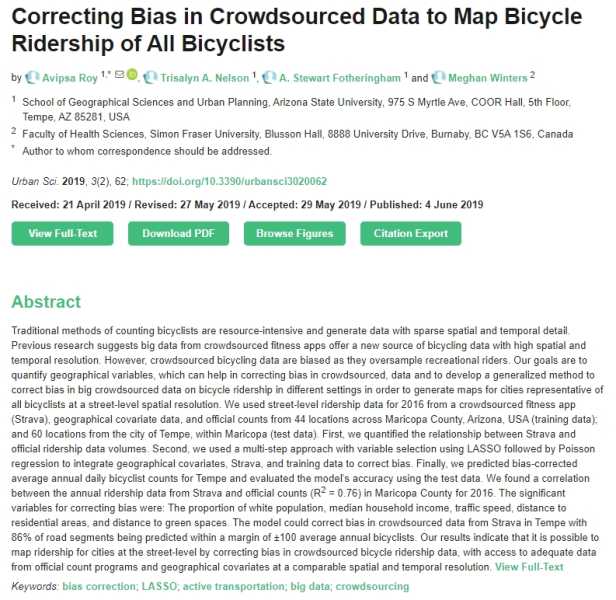Correcting Bias in Crowdsourced Data to Map Bicycle Ridership of All Bicyclists
Tipo de publicação
Artigo
Curso ou área do conhecimento
Urbanismo
Veículo
Uban Science
Tipo de autoria
Pessoa Física
Nome do autor
Avipsa Roy et alii
Língua
Inglês
Abrangência geográfica
País estrangeiro específico
País
Estados Unidos
Ano da publicação
2019
Palavra chave 1
Big data
Palavra chave 2
Crowdsourcing
Palavra chave 3
georreferenciamento
Palavra chave 4
Infraestrutura
Palavra chave 5
Mapeamento
Palavra chave 6
Strava Metro
Descrição
Traditional methods of counting bicyclists are resource-intensive and generate data with
sparse spatial and temporal detail. Previous research suggests big data from crowdsourced fitness
apps offer a new source of bicycling data with high spatial and temporal resolution. However,
crowdsourced bicycling data are biased as they oversample recreational riders. Our goals are to
quantify geographical variables, which can help in correcting bias in crowdsourced, data and to
develop a generalized method to correct bias in big crowdsourced data on bicycle ridership in different
settings in order to generate maps for cities representative of all bicyclists at a street-level spatial
resolution. We used street-level ridership data for 2016 from a crowdsourced fitness app (Strava),
geographical covariate data, and official counts from 44 locations across Maricopa County, Arizona,
USA (training data); and 60 locations from the city of Tempe, within Maricopa (test data). First,
we quantified the relationship between Strava and official ridership data volumes. Second, we used a
multi-step approach with variable selection using LASSO followed by Poisson regression to integrate
geographical covariates, Strava, and training data to correct bias. Finally, we predicted bias-corrected
average annual daily bicyclist counts for Tempe and evaluated the model’s accuracy using the test
data. We found a correlation between the annual ridership data from Strava and official counts (R2 =
0.76) in Maricopa County for 2016. The significant variables for correcting bias were: The proportion
of white population, median household income, traffic speed, distance to residential areas, and
distance to green spaces. The model could correct bias in crowdsourced data from Strava in Tempe
with 86% of road segments being predicted within a margin of ±100 average annual bicyclists. Our
results indicate that it is possible to map ridership for cities at the street-level by correcting bias in
crowdsourced bicycle ridership data, with access to adequate data from official count programs and
geographical covariates at a comparable spatial and temporal resolution.



 Ao navegar no Observatório da Bicicleta você concorda com os
Ao navegar no Observatório da Bicicleta você concorda com os